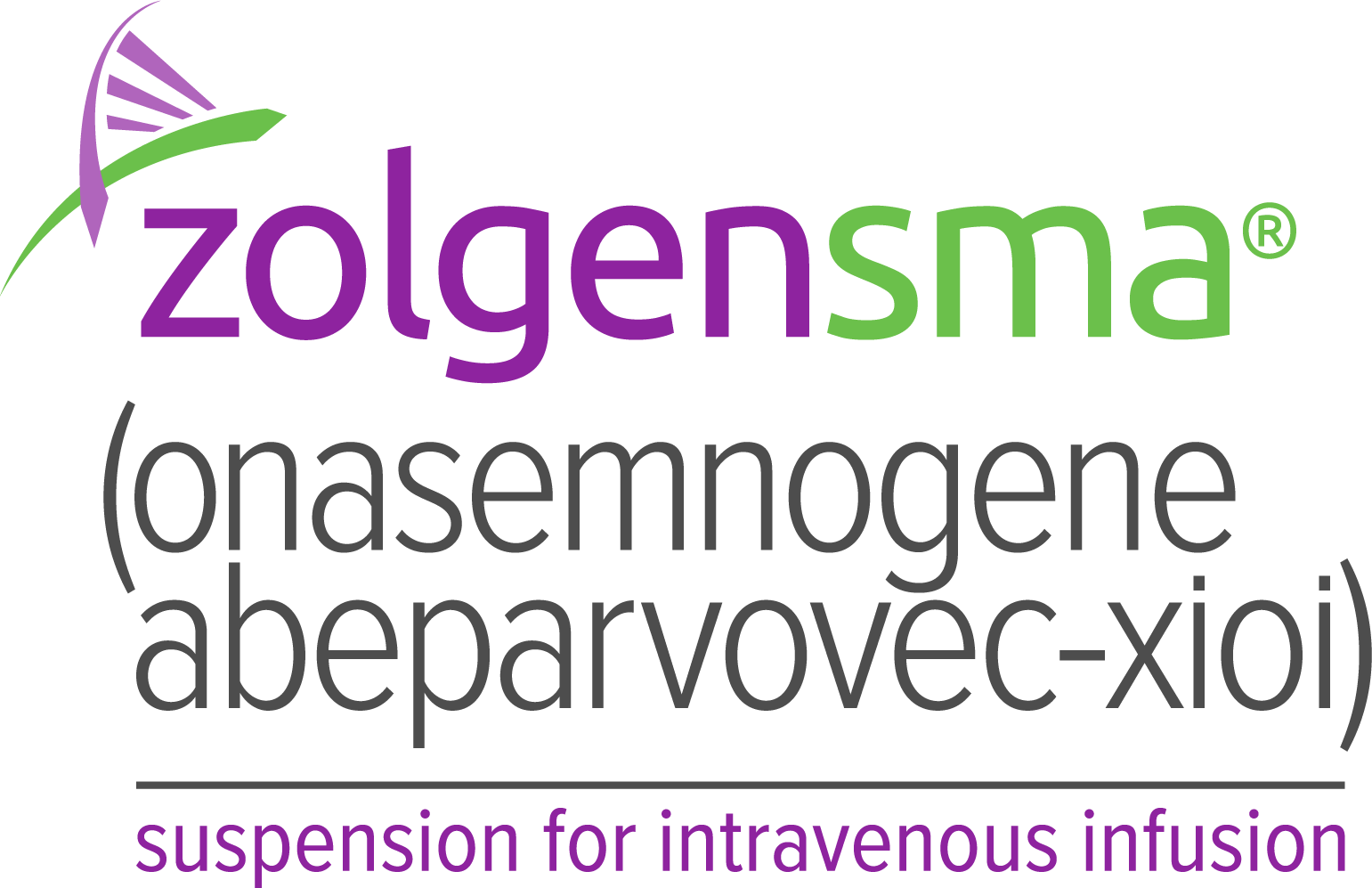VOICE-OVER
ZOLGENSMA (onasemnogene abeparvovec-xioi) is a gene therapy for the treatment of pediatric patients less than 2 years of age with spinal muscular atrophy (SMA).
ZOLGENSMA has a Boxed WARNING for Serious Liver Injury and Acute Liver Failure. Please see additional Important Safety Information at the end of this video. Please see the accompanying Full Prescribing Information.
DR SHIEH
I always want to impress upon my patients that SMA is a progressive disease.
DR RAO
The earlier the treatment, the better the outcome.
DR TESI ROCHA
So, that's why it's so important for us to act fast and act urgently.
DR RAO
Our whole team is geared towards making sure that all the steps going from receiving the diagnosis to treatment are shortened as much as possible.
DR TESI ROCHA
The longer we wait to treat, the less effective these treatments will be.
DR TESI ROCHA
We always keep in our clinic days these kind of emergent slots for patients. So, patients could be accommodated after the diagnosis or the referral in 24-48 hours.
DR SHIEH
When we see a patient, we are already thinking about the schedule. When is a patient going to come in? When are we going to be able to start treatment? How are we going to get insurance authorizations so that we can procure drug?
DR RAO
In my experience, the common barriers to ZOLGENSMA treatment can be sort of thought of in two categories. There are the medical barriers, and then there are the nonmedical barriers to treatment. The medical barriers are somewhat obvious in the sense that you need to be eligible for ZOLGENSMA treatment.
DR RAO
And to be eligible for ZOLGENSMA treatment, because it is delivered via a viral vector, you cannot possess antibodies to the vector.
DR TESI ROCHA
So a patient can be seronegative at birth or in the first months when this diagnosis is made, but later on they might become positive. And then they will not longer be a candidate for at least this treatment.
DR TESI ROCHA
There's always, like the possibility of retesting. So, we know that since these titers are transmitted maternally, then those titers will eventually go down.
DR RAO
The nonmedical barriers to ZOLGENSMA treatment that I have seen in my experience can range anywhere from the status of the patient in terms of their socioeconomic, financial, and other logistical barriers that that may encounter, such as transportation, all the way to being uninsured.
DR TESI ROCHA
For those families that live far away, sometimes that happen in our center. We also offer a telehealth visit, so we can go over the details of the diagnosis and treatment. And then they can come back whenever is easier for them, a week later or something like that, for us to be able to do the exam.
DR SHIEH
One of the main barriers we run into in treating patients is getting treatments covered by insurance. So this includes expensive medications such as ZOLGENSMA, but also equipment, for instance, a power wheelchair or some of the other equipment that these patients may need.
DR SHIEH
In our clinic, we have a social worker who's able to meet with all our patients. And they're able to discuss some of the challenges they have in receiving treatment, some of the challenges they have in coming to our clinic.
DR TESI ROCHA
And you also have the industry as well that they are important role these days to navigate with these patients through the diagnosis process, and also to the treatment and the follow-ups.
DR RAO
And these support services can exist at multiple levels. They're at my clinic. They can be at an institution. But there's also the OneGene Program that Novartis provides that can help families with ZOLGENSMA access.
DR TESI ROCHA
Social media plays a big role as well these days. But we have to be very careful with information that is provided by social media.
DR RAO
In addition to treating children with the one-time dose with ZOLGENSMA, we also talked to families prior to the infusion about the need to start a dose of steroid that is to be given daily starting the day before the ZOLGENSMA infusion.
DR TESI ROCHA
We have created a roadmap that is shared with the families at the time of discussion about the treatment options, where they can easily see in a diagram how many times they will have to come to the visit after the treatment.
DR SHIEH
It's important that they, for instance, take the steroid dose that we give them and that they take it every day. And that they come in for all the laboratory monitoring that we ask them to do. We make weekly phone calls, sometimes more frequently than weekly phone calls to connect with our patients so that they understand that. We actually try to instill some fear in them so that they realize that not following our instructions may result in bad outcomes.
DR TESI ROCHA
Even if the patient looks great, they still need to adhere to those follow-up visits that we stipulated at the beginning of the treatment. So we, we always prioritize safety and we convey this information for other providers but also to the families when they get these treatments.
VOICE-OVER
Please see additional Important Safety Information at the end of this video.
Indication and Important Safety Information for ZOLGENSMA (onasemnogene abeparvovec-xioi)
INDICATION
ZOLGENSMA is an adeno-associated virus (AAV) vector-based gene therapy indicated for the treatment of pediatric patients less than 2 years of age with spinal muscular atrophy (SMA) with bi-allelic mutations in the survival motor neuron 1 (SMN1) gene.
Limitations of Use
The safety and effectiveness of repeat administration or the use in patients with advanced SMA (eg, complete paralysis of limbs, permanent ventilator dependence) has not been evaluated with ZOLGENSMA.
IMPORTANT SAFETY INFORMATION
BOXED WARNING: Serious Liver Injury and Acute Liver Failure
Cases of acute liver failure with fatal outcomes have been reported. Acute serious liver injury, acute liver failure, and elevated aminotransferases can also occur with ZOLGENSMA. Patients with preexisting liver impairment may be at higher risk. Prior to infusion, assess liver function of all patients by clinical examination and laboratory testing. Administer systemic corticosteroid to all patients before and after ZOLGENSMA infusion. Continue to monitor liver function for at least 3 months after infusion, and at other times as clinically indicated. If acute serious liver injury or acute liver failure is suspected, promptly consult a pediatric gastroenterologist or hepatologist.
WARNINGS AND PRECAUTIONS
Systemic Immune Response
Patients with underlying active infection, either acute or chronic uncontrolled, could be at an increased risk of serious systemic immune response. Administer ZOLGENSMA to patients who are clinically stable in their overall health status (eg, hydration and nutritional status, absence of infection). Postpone ZOLGENSMA in patients with infections until the infection has resolved and the patient is clinically stable.
Thrombocytopenia
Transient decreases in platelet counts, some of which met the criteria for thrombocytopenia, were typically observed within the first 2 weeks after ZOLGENSMA infusion. Monitor platelet counts before ZOLGENSMA infusion and on a regular basis for at least 3 months afterwards.
Thrombotic Microangiopathy
Cases of thrombotic microangiopathy (TMA) were reported to occur generally within the first 2 weeks after ZOLGENSMA infusion. TMA can result in life-threatening or fatal outcomes. Obtain baseline creatinine and complete blood count before ZOLGENSMA infusion. Following infusion, monitor platelet counts closely as well as other signs and symptoms of TMA. Consult a pediatric hematologist and/or pediatric nephrologist immediately to manage as clinically indicated.
Elevated Troponin I
Increases in cardiac troponin I levels have occurred following ZOLGENSMA infusion. Consider cardiac evaluation after ZOLGENSMA infusion and consult a cardiologist as needed.
AAV Vector Integration and Risk of Tumorigenicity
There is a theoretical risk of tumorigenicity due to integration of AAV vector DNA into the genome. Cases of tumor have been reported in patients who received ZOLGENSMA post-approval; a causal relationship has not been established based on tumor analysis. In some cases, limited information was available. Report cases of tumor development in patients who received ZOLGENSMA to Novartis Gene Therapies, Inc. at 1-833-828-3947.
Infusion-Related Reactions
Infusion-related reactions, including hypersensitivity reactions and anaphylaxis, have occurred with ZOLGENSMA infusion. Signs and symptoms may include rash, urticaria, vomiting, dyspnea, respiratory symptoms, and/or alterations in heart rate and blood pressure. Monitor patients during and after treatment with ZOLGENSMA. If an infusion-related reaction occurs, interrupt ZOLGENSMA infusion and administer supportive treatment to manage the infusion-related reaction as appropriate. Infusion of ZOLGENSMA may be resumed based on clinical assessment.
ADVERSE REACTIONS
The most commonly observed adverse reactions (incidence ≥5%) in clinical studies were elevated aminotransferases and vomiting.
Please see Full Prescribing Information.
Please visit ZOLGENSMA-hcp.com for more information.
5/25 FA-11419929

